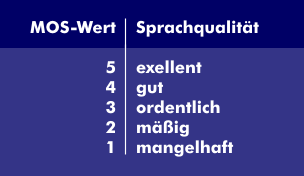voice quality
The quality of voice transmission in circuit-switched telephone networks, in packet-switched IP networks or in mobile communications networks is decisive for speech intelligibility between the call partners.
Voice quality is determined by the available bandwidth and by voice codecs with their voice compressions. Voice quality is impaired by echoes, interference and crosstalk, as well as by packet loss, jitter and delays. Codecs with high compression require less bandwidth, but tend to have higher error rates and quality losses.
As far as bandwidth is concerned, the International Telecommunication Union( ITU) addressed the issue back in the 1980s and, in ITU Recommendation G.722, expanded the narrowband frequency range for telephony between 300 Hz and 3.4 kHz into a widerband frequency range to improve voice quality. The improved voice quality is called High Definition Voice( HD Voice) and is used in HD telephony.
Objective and subjective evaluation criteria
Regardless of the type of impairment, there are objective and subjective ratings for voice quality. The International Telecommunication Union (ITU) has developed a method for the objective assessment with the E-model, which is specified in the G.107 standard and which is based on reproducible interference quantities. The R factor is used to quantify voice quality and the quality of voice transmission. The subjective evaluation is expressed in the MOS values, the Mean Opinion Score (MOS), and in the methods for evaluating voice quality refined by the ITU-T in Recommendations Q.800 and Q.830.
In addition to the MOS value, the R factor plays a decisive role in voice communication using VoWLAN. This depends on the packet loss rate, jitter and delay.
An objective evaluation criterion for intelligibility is the Articulation Score( AS). Other evaluation methods for speech quality include measurement methods for the signal-to- noise ratio, echo measurement, Perceptual Evaluation of Speech Quality( PESQ), Perceptual Speech Quality Measurement( PSQM), Perceptual Analysis Measurement System ( PAMS) and Multimedia Perception Assessment Center ( MPAC).


